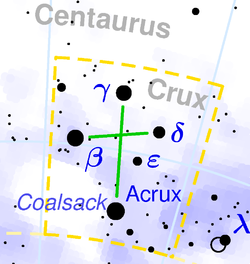 The Southern Cross is the most famous constellation and symbol of the southern sky. As a separate constellation, it was probably first drawn on star charts by Portuguese seafarers in the 16th century, who needed some sort of landmark to help them locate the South Celestial Pole during their sea voyages. In areas north of the equator, the Polaris chart fulfils this function perfectly, showing almost exactly the location of the North Celestial Pole, the cardinal points and the latitude. In the southern hemisphere, however, we can no longer see the Arctic Circle and the North Celestial Pole, so we have to take a slightly different approach to orientation. We start from the conjunction of Toliman and Agent, the two brightest stars of Centaurus, which point to the true Southern Cross, thus not to be confused with the nearby False Cross, lying 45 degrees to the west. The longer arm of the Southern Cross, 4.5 times the superimposed distance of the stars α and γ Crucis, then points virtually into the starless region where the South Celestial Pole is located.
The Southern Cross is the most famous constellation and symbol of the southern sky. As a separate constellation, it was probably first drawn on star charts by Portuguese seafarers in the 16th century, who needed some sort of landmark to help them locate the South Celestial Pole during their sea voyages. In areas north of the equator, the Polaris chart fulfils this function perfectly, showing almost exactly the location of the North Celestial Pole, the cardinal points and the latitude. In the southern hemisphere, however, we can no longer see the Arctic Circle and the North Celestial Pole, so we have to take a slightly different approach to orientation. We start from the conjunction of Toliman and Agent, the two brightest stars of Centaurus, which point to the true Southern Cross, thus not to be confused with the nearby False Cross, lying 45 degrees to the west. The longer arm of the Southern Cross, 4.5 times the superimposed distance of the stars α and γ Crucis, then points virtually into the starless region where the South Celestial Pole is located.
Small and distinctive, but invisible in our latitudes, the constellation of the southern sky. The brilliant stars form a typical cross pattern captured in the southern part of Centaurus. However, because it lies in one of the most beautiful and extraordinarily rich regions of the Milky Way, it does not stand out above its surroundings. We can admire a pair of very different objects in it - with the naked eye, note the striking dark region called the Coal Sack, while in the binocular, the sparkling open cluster of the Jewel Cluster around the star Kappa Crucis catches the eye.
β Cru - The pale blue star is located 350 light-years away. With its brightness of 1.3 magnitude, it ranks among the twenty brightest stars in the sky. Its size changes five times a day due to pulsation, but its magnitude changes by less than a tenth, which is not enough for us to perceive with the naked eye.
Acrux (α Cru) - The brightest star of the constellation has a magnitude of 1.1 and is the 13th brightest star in the sky. In a telescope, we can distinguish it as two sparkling blue-white components separated by 4.4". They have magnitudes of 0.8 and 2.1, and we can separate them with a 60 mm telescope. The system is located at a distance of 370 light-years. We can find a third unrelated component with a magnitude of 5 in a refractor 90" away.
Gacrux (γ Cru) - Red giant (1.6 mag), which nicely contrasts with three other hot blue-white stars of the cross. In fact, it is an optical double star, with a companion of magnitude 6.5 mag found in a distance of 2'. The red giant is located at a distance of 88 light years from us, while the companion is three times further away.
μ Cru - Wide optical double star, which can be observed as two stars with magnitudes 4.1 and 5.1 through a small telescope or a powerful refractor. The fainter star rapidly rotates around the primary star, emitting gas streams, which occasionally cause small changes in brightness.
NGC 4755
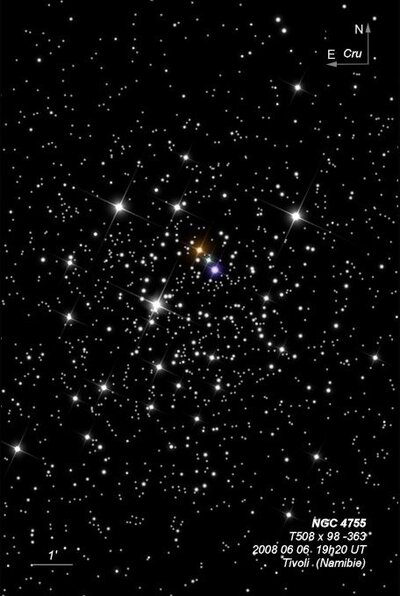
10x30mm Canon IS (3/27/19 - Tasmania): the Jewel Box is bright naked-eye cluster close to Beta Crucis (Mimosa). Several very bright stars were resolved and some fainter stars using the 10x30 binoculars.
Nicolas-Louis de Lacaille discovered NGC 4755 = Lac II-12 = D 301 = h3435 in 1751 through a 1/2" telescope during his expedition to the Cape of Good Hope. He classified it as a nebulous star cluster and noted "5 or 6 small stars between two of sixth magnitude". It was probably next observed at the Parramatta Observatory during regular meridian work and described as "a cluster of 12 or 14 small stars, in the form of a rhomboid, very close together. Part of this cluster forms a very perfect cone of mixed stars." Using his 9-inch speculum reflector in 1826, James Dunlop described "(Kappa Crucis, Bode) is five stars of the 7th magnitude, forming a triangular figure, and a star of the 9th magnitude between the second and the third, with a multitude of very small stars on the south side - Figure 13 is a very correct representation."
John Herschel first observed the cluster on 14 Mar 1834 and recorded "the central star (extremely red) of a most vivid and beautiful cluster of from 50 to 100 stars. Among the larger there are one or two evidently greenish; south of the red star is one 13th mag, also red; and near it is one 12th mag, bluish." In preparation for his meticulous sketch of the cluster, he drew up a catalogue of 110 stars, accompanied by the following explanation: "Though set down by Lacaille as nebulous, and on that authority entered as a nebula in Bode's Catalogue, no nebula is perceptible in any part of the extent of this cluster, which though neither a large nor a rich one, is yet an extremely brilliant and beautiful object when viewed through an instrument of sufficient aperture to show distinctly the very different colour of its constituent stars, which give it the effect of a superb piece of fancy jewelery. The area occupied by it is about one-forty-eighth part of a square degree, within which area I have laid down, partly from micrometric measures (as regards the large stars) and partly from intertriangulation by the eye (as respects the small ones) the stars (110 in number) of the following catalogue." JH listed eight stars in which the "colour is conspicuous"; 3 are described as "greenish-white, 2 are green, 1 blue-green, 1 red and 1 ruddy.
In May 1862, English amateur astronomer and meteoroligist Francis Abbott constructed a map of 75 stars (from Hobart, Tasmania) five of which Abbott thought were not shown by Herschel. He commented "certain changes are apparently taking place in the number, position, and colours of its component stars." In 1872 Henry Chamberlain Russell, director of the Sydney Observatory, decided to investigate Abbott's claim and carefully measured the positions of the stars using the observatory's 7.25" refractor and creating a catalog of 130 stars. He mistakenly noted change also, as he thought several stars had changed their positions based on Herschel's sketch and several faint stars that Russell measured were surprisingly missed by JH. Russell later took perhaps the first photograph of the cluster in 1891. In 1929 Trumpler classified the cluster as type I 3 r -; "Detached, strong concentration, bright and faint stars in the cluster, rich in stars, without nebulosity."
300/350mm - 12" (6/29/02 - Bargo, Australia): the Jewel Box cluster is a beautiful, naked-eye cluster about a degree SE of Beta Crucis. At 186x, the cluster includes a half-dozen very bright stars (mag 6-7.5) set over a rich background of scores of mag 9-13 stars within a compact 10' diameter. A line of three mag 6-7 crosses the center of cluster from NW to SE with a striking orange-red variable star (DU Crucis = SAO 252073) near the center. Other stars have blue-white and yellow-whites tints, though these are more subdued. To the south of the cluster is the remarkable 6°x4° oval dark Coalsack which sits adjacent to the SE side of the Southern Cross.
Notes by Steve Gottlieb
NGC 4349
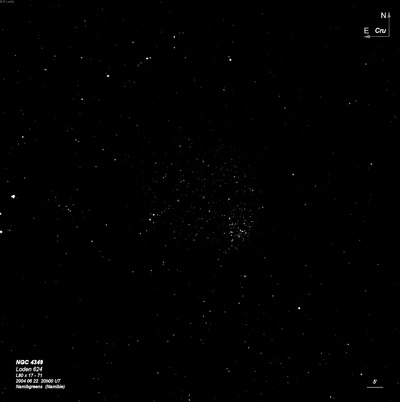
10x30mm Canon IS (3/27/19 - Tasmania): fairly faint, large glow, appears oval or elongated. No resolution except for a star at the edge.
James Dunlop discovered NGC 4349 = D292 on 30 Apr 1826 and described "a pretty cluster of extremely small stars, resembling a pretty large faint nebula, about 6' or 7' diameter: the compression is very gradual to the centre; a pretty bright star is in the following side of the cluster, round figure." His position was quite accurate (about 4' SE of the center of the cluster near the brightest member). The position here corresponds with the densest portion of the cluster.
JH observed the cluster on three sweeps. On 14 Mar 1834 he logged "chief star 10m of a fine rich cluster which fills field." Two weeks later (31 Mar 1834) he noted "a large loose cluster of small stars 12..14th mag; irregularly round; not very rich; little compressed in the middle; diam. 10'." His final sweep three years later described a "cluster class VI. Very large, very bright, A star about 8..9 mag taken but the brightest part of the cluster is about 4' N.p. Fills field; not much compressed in the middle; stars 12..13th mag; This cluster was found by Mr Maclear in this sweep made with him, not being aware at the time of its having been seen in Sweep 432."
300/350mm - 13.1" (2/20/04 - Costa Rica): at 105x, ~150 stars are resolved in a 15' field. This cluster is rich and uniform in magnitudes except for a single mag 8.4 star (HD 107944) on the SE side which stands out over the large number of mag 10.5-12.5 stars. The outline is elongated NW to SE but the stars are distributed fairly evenly within the boundaries. This is a very pleasing group and an easy binocular object. Located along the western side of the Southern Cross and 75' NNW of Alpha Crucis (Acrux)!
Notes by Steve Gottlieb
NGC 4103
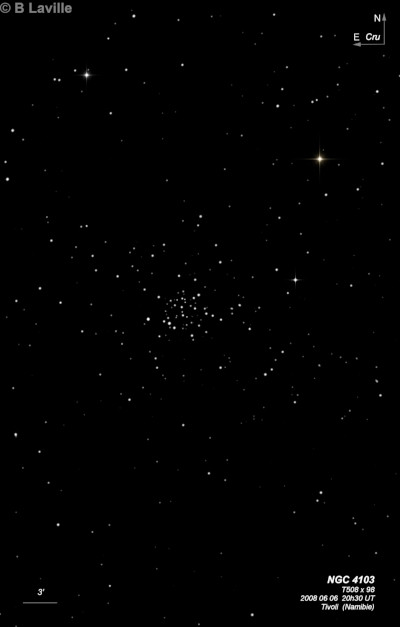
10x30mm Canon IS (3/27/19 - Tasmania): moderately bright cluster, perhaps 8' diameter, mottled but no obvious resolution. Situated within a large, glowing naked-eye patch of the Milky Way that includes two bright stars.
James Dunlop discovered NGC 4103 = D 291 = h3377 on 30 Apr 1826 and recorded "a cluster of small stars of mixt magnitudes, irregular figure, about 6' long and 4' broad." His position was 12' too far west.
John Herschel observed the cluster on 3 sweeps. On 14 Mar 1834 he logged "middle of a rich, large, irregularly round cluster; poor VI or rich VII, stars 10..14 mag; diam 5' with stragglers." His second observation was made under poor conditions: "cluster of stars class VII, pretty rich and compact, stars 10..12 mag, and nearly equal; diameter 5'; the whole field is in a state of wavy fluctuation, owing to the southeast wind, and so bad that each star is dilated into a large puff ball." The final sweep was recorded as "A 10th mag star in centre of a pretty rich close cluster; 5' diameter; irregularly round; stars 10..13 mag."
300/350mm - 13.1" (2/20/04 - Costa Rica): at 105x, ~60 stars mag 9.5-13 are resolved in a 8' region including roughly ten mag 10 stars. The cluster has a very interesting asymmetric arrangement with a perfect 5' string of five stars extending out of the cluster to the WSW. At the west end of the string is the 10th magnitude variable AI Crucis. Two other short strings on the eastern end of the cluster meet up and make a perfect arrow asterism. NGC 4103 is located 12' ESE of mag 6.6 HD 104971 and two degrees WSW of mag 3.6 Epsilon Crucis.
Notes by Steve Gottlieb
NGC 4052
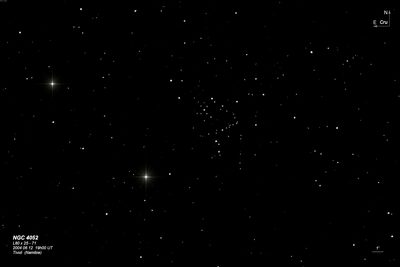
John Herschel discovered NGC 4052 = h3373 on 8 Mar 1837 and logged "Cluster VII class; loose and scattered but pretty rich." There is nothing at his position, but 1 min of RA west is a scattered cluster.
300/350mm - 13.1" (2/20/04 - Costa Rica): this cluster is located in the field, just 10' NW of mag 4.3 Theta 1 and 15' W of mag 4.7 Theta 2 Crucis in the SW portion of the constellation! At 105x, ~60 stars mag 10 and fainter are mostly scattered in a 9' diameter. More striking, though, is a dense 3' subgroup of mostly mag 12-13 stars on the SE end of the cluster over a background of haze from unresolved stars. A neat string of six stars oriented WNW-ESE is located on the south end with a brighter mag 9.5 star about 2.5' further west.
Notes by Steve Gottlieb
NGC 4609
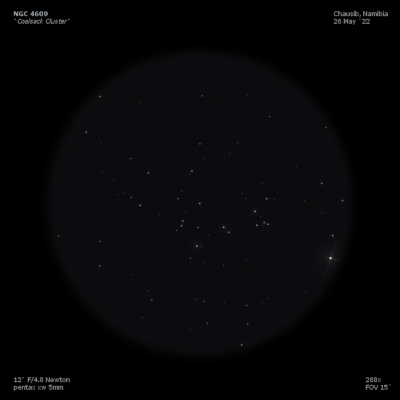
10x30mm Canon IS (3/27/19 - Tasmania): faint, small glow attached to a bright star (BZ Crucis).
James Dunlop discovered NGC 4609 = D 272 = h3407 on 12 May 1826 with his 9-inch f/12 homemade speculum reflector from Parramatta, New South Wales and recorded "a group of five stars of the 8th or 9th magnitude, with a great number of extremely small stars resembling faint nebulae. 3' or 4' diameter." His position is about 9' too far west. JH called it a "Cluster class VII. Stars 11..13th mag; about 6' long and 4' broad; has 10 stars 11th mag, and some 20 or 30 smaller. It occurs in the midst of the black space following Alpha Crucis, which is by no means void of stars."
300/350mm - 13.1" (2/20/04 - Costa Rica): at 166x, 30 stars mag 9.5-13 are resolved in a 4'-5' region. Most of the stars are arranged in a curving lane ~NNW-SSE with fainter stars trailing off to the NNW and a few stars scattered to the east. The main string is oriented roughly N-S and bends towards the east on the north side. The cluster includes some doubles and triples with a nice mag 10.5 star pair at 15" and a distinctive triple on the south end of the lane. Situtated just 7' NW of mag 5.3 BZ Crucis = HD 110432. This star is located within the Coal Sack, 1.8 degrees east of Acrux, and is the only easy naked-eye star with the Coal Sack! The cluster resides behind the Coal Sack and is dimmed accordingly.
Notes by Steve Gottlieb
NGC 4439
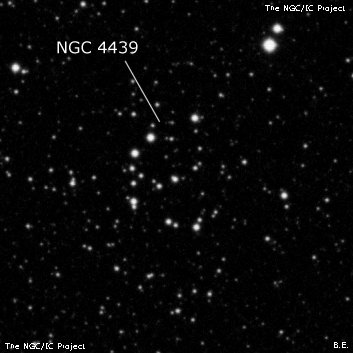
James Dunlop discovered NGC 4439 = D 300 on 30 Apr 1826 and described "a triangular group of very small stars, about 3' long, resembling faint nebulae. A star of the 9th magnitude near the north following extremity [the bright star is NW of the cluster]." His position is 7' too far east, but the identification is certain.
JH observed the cluster on 31 Mar 1834 and noted "Cluster taken for Dunlop 300; a semi-elliptic group of stars 11..12th mag, diameter 2'."
300/350mm - 13.1" (2/20/04 - Costa Rica): at 105x, 20 stars mag 10-13 are arranged in a perfect semi-circle (180 degree arc) open towards the west, with the endpoints directly N-S. A string of three collinear stars, oriented WNW-ESE, sits right in the middle of the semicircle! A wide bright double (HJ 4524 = 8/9.5 at 30") situated less than 5' NW is aligned directly with the center of the cluster! Situated in the middle of the Southern Cross, 55' ENE of mag 3.6 Epsilon Crucis.
Notes by Steve Gottlieb
NGC 4337
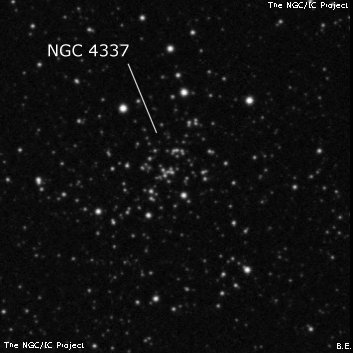
John Herschel discovered NGC 4337 = h3388 on 1 Apr 1834 and reported "a p rich cl; not much compressed in the middle; stars 12...14m, in curved branches. A fine double star follows [Brs 8]." His position is just west of center of this cluster.
300/350mm - 13.1" (2/20/04 - Costa Rica): at 105x, ~15 stars are arranged in a striking 4.5' diameter partial oval for ~270 degrees and open on the west side. A few stars are situated both in the interior and outside of this three-fourth completed ring. In the center of the loop are a few mag 13-14 stars and a fairly bright background glow from a dense group of unresolved stars in the core of the cluster. A gorgeous, equal mag double star Brs 8 = 7.6/7.9 at 5" is located 6' E. The cluster is located midway between Delta and Gamma Crucis along one side of the Southern Cross. This group may be an asterism an not a physical cluster.
Notes by Steve Gottlieb